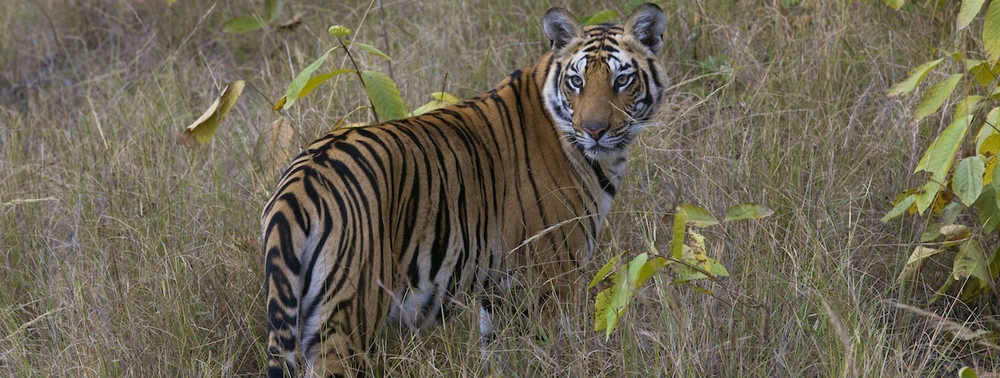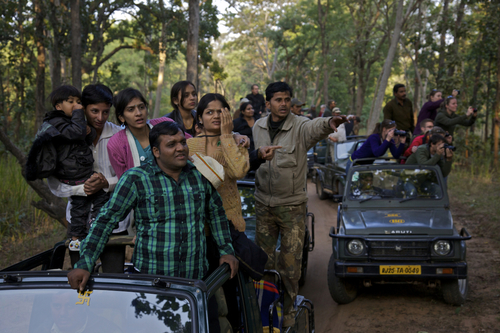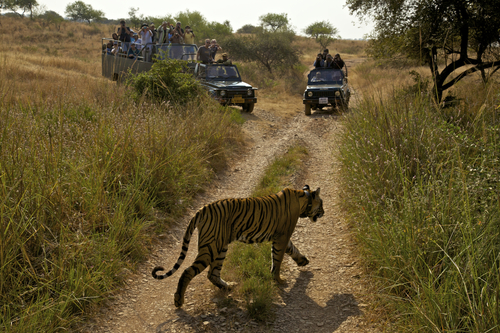Crouching Tiger: India’s National Parks
Face-to-face with one of nature’s most majestic creatures, our writer looks closely at how tiger tourism may offer the best hope for saving India’s wild cats
Photos and Story By Don Mankin
“Tigers, schmigers, who cares?” I thought as our car pulled into Kanha Jungle Lodge at the edge of Kanha National Park, the first of our two stops in the tiger reserves of central India. After several days of the barely managed chaos of Delhi, Jaipur, and Agra, my wife and I were simply ready for some quiet, fresh air, and nature.
After a 14-hour overnight rail trip and a 4.5-hour drive to get here from Agra, the first thing I noticed was the absence of man-made sound. Unlike in the cities, we had just visited, human beings are bit players in Kanha, not an overriding presence. The lodge and its setting were so soothing and peaceful, I would have been happy to just stretch out on the deck and chill for the next few days. But we were here to see tigers.
Although tiger sightings are a hit-or-miss affair in most of India’s national parks, Kanha has one of the largest populations of Royal Bengal tigers in the world, and our next stop, the significantly smaller Bandhavgarh National Park, has the highest concentration, so the odds were good. We were further encouraged by fellow guests’ stories and photos of a tiger they had seen just a few hours earlier trying to climb a tree to reach a leopard on a high branch.
On five game drives over the next two and a half days, we had no such luck. But from the open seats of our gypsy Jeeps, we saw lots of wildlife – monkeys, deer, wild boar, peacocks, and other birds, and an Indian bison, a creature with muscles the bodybuilders at my gym would die for. Plus, the scenery was beautiful. My body, cramped by days of driving in and between cities, was longing for a stroll in the inviting meadows and forests. Our guides quickly squelched that idea by reminding me of the tigers, leopards, and other predators just waiting for a fool like me to wander by.

The absence of tigers didn’t mean an absence of excitement. On our first morning game drive, I heard a rustle by the side of the road and turned around to see what was up. What I saw was one angry cobra standing straight up like a stick, hood spread wide. That black tube of sinister muscle framed against the clear blue sky was one of the most chilling sights I have ever seen.
After three days in Kanha, we headed to Bandhavgarh, a seven-hour drive away. Bandhavgarh is even more beautiful than Kanha, with steep cliffs overlooking forests, meadows, and ponds. And by now I really wanted to see a tiger.
Our first morning drive started out dark, cold, and misty. After only a few minutes our guides spotted fresh tracks heading up the dusty road. We stopped when we heard alarm calls from the jungle at the far edge of a wide meadow. I aimed my binoculars and held my breath. As my heart pounded a female tiger emerged from the jungle and glided across the meadow, rippling with efficient grace.
When she disappeared into the jungle at the other end of the meadow, we moved 100 yards down the road and waited for her to reemerge. A minute later she did, walking toward us just 50 yards away before disappearing again behind a rise.
Anticipating her path, we drove another 100 yards down the road, then stopped and waited. Less than a minute later, the guide pointed urgently to the roadside. There she was, crouched and partially shielded by grass and brushes just a few feet away, about even with me. We stared at each other for a moment, eyeball to eyeball. Then she lunged at me and hissed. It happened so quickly, I didn’t even have time to wet my pants.
She moved a few feet ahead and crossed the road just 10 or 15 feet away, stopping on the other side for a moment to glare at me once again before slipping back into the jungle.
“It was a mock charge,” the guide explained later. We had inadvertently parked where she wanted to cross the road, so she was pissed. We were never in danger since we looked like part of the jeep to the tiger, but if we had been standing on the ground, it would have been a different story.
I couldn’t get these words out of my mind the next morning as we hiked to the century-old Hindu fort on the cliff at the highest point in Bandhavgarh – the only place where visitors are allowed to hike, and only with a guide. On the way to the trailhead, we spotted fresh tracks in the road. A large male tiger was heading in the same direction as we were. The trail first took us through the forest, then along the top of the cliff with commanding views of volcanic calderas, jungle, and savannas below. We followed the tracks all the way, even passing by a pile of glistening scat only a couple of hours old. We didn’t see the tiger, though he may have seen us. It was the only time on the trip that I was relieved not to see a tiger.
We had a couple of other tiger sightings, plus a fleeting glimpse of a leopard running across the road, but the glaring, hissing, mock-charging tiger on our first day in Bandhavgarh still stands out most in my memory. It was the highlight of our two weeks in India.
So it was with some dismay when I found out that in July the Indian Supreme Court had placed a moratorium on tourism in the country’s tiger reserves until they could assess the impact on the tiger population. This is a serious concern. In just over 100 years, tiger populations worldwide have dropped from about 100,000 to somewhat over 3,000, of which slightly more than half are in India.
The critical question underlying the Court’s decision is, “Does tourism threaten the tigers or help them?” Clearly, the complainant who filed the lawsuit believes the former. Others, including most tour operators and many conservationists, disagree. Julian Matthews, chairman of Travel Operators for Tigers (TOFT), an advocacy organization supporting responsible tiger tourism, notes that “the most-visited tiger reserves in India have the highest tiger densities.” And as Amit Sankhala, a noted wildlife conservationist and tour operator who hosted my five nights at the Kanha and Bandhavgarh jungle lodges, argues, “more eyes on the tigers protect the tigers and the communities around them.”

Tiger tourism provides jobs for local people, jobs that depend on the welfare and survival of the animals. Local people working in the parks, lodges, and souvenir shops are less likely to destroy tiger habitat, shoot tigers when they encroach on their fields or poach them for body parts to sell to purveyors of questionable but lucrative medicinal remedies.
Make no mistake about it: Tigers are what brings tourists to the area. “Our travelers go to India hoping to see tigers, and the local community guides we have helped train to track them hope to see the tourists!” says Kurt Kutay, president of Wildland Adventures, whose “Tigers and Travels in India” program has earned Tour of a Lifetime honors from National Geographic Traveler magazine.
The economic impact is substantial. TOFT’s Matthews estimates that a single tigress in Ranthambore, one of India’s biggest and most popular reserves, generated direct revenues of over $100 million for the local area in her last 12 years of life.
What I saw and experienced in Kanha and Bandhavgarh provides anecdotal support for this argument. Our visit involved a driver and two guides on every drive, plus all of the lodge staff who fed us, cleaned our rooms, and maintained the property, as well as behind-the-scenes managers and the vendors and suppliers who provided food, materials, and equipment.
Furthermore, the process seemed very well managed and designed to protect all wildlife, not just tigers. The jeeps used for tourists are small and relatively unobtrusive, with room for a handful of passengers at most. In both parks, each jeep is assigned one of several different routes through the reserve in an effort to reduce congestion. Off-road driving is strictly forbidden.
However, as Sankhala notes, compliance with the rules is often a problem: “Although there is a guideline of no crowding around a tiger, not many people follow it. What we need are rules and regulations that address the issue of us not following rules.”


Sankhala may have gotten his wish. On October 16, the Indian high court lifted the ban but restricted new development and asked state governments to draw up new conservation plans and regulations to protect critical tiger habitat. Sankhala is cautiously optimistic since it remains to be seen whether the main problems have actually been addressed, and whether the local area committees meant to play important advisory roles will be effective. “The [approved] guidelines still contain provisions that leave a question mark over the future development of wildlife tourism,” he notes, but at least “states and individuals will be free to challenge elements of these guidelines in the courts and there is space for individual states to interpret key aspects of the guidelines.”
The big unanswered question for Sankhala is whether tour operators, lodge owners, and other stakeholders will be included in the deliberations. In words that reflect the wish of everyone involved, including tourists looking for that once-in-a-lifetime experience, Sankhala concludes, “We want good tourism to flourish, and hopefully we will find ways in the coming months to do so.”



